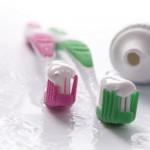
Despite continuing improvements in dental health considerable inequalities remain with highest levels of disease amongst children living in the most materially disadvantaged areas.
The main aim this study was to assess the caries-preventive efficacy of a 2 years twice weekly supervised brushingprogramme using a self-applied gel containing 12,500 ppm fluoride on schooldays compared with weekly supervised use in children at high caries risk (with prior caries experience on first permanent molars). A second aim was to assess efficacy compared with similar children who continued with their usual oral hygiene care.
Pupils were randomised to two test groups and one untreated control group. 1,075 pupils aged 12–13 years at baseline received a baseline and final examination 2 years later.
They found
- No significant difference between groups in those children completing the trial.
- In those children compliant with study protocol no significant difference was found in the primary outcome (D 1 FS caries increment), but significant differences were found between the three groups overall in the secondary outcome, D 3 FT caries increment, with a significant pairwise difference between control and twice per week gel brushing (29%, p = 0.023 D 3 FT visual + fibre-optic transillumination
- Analysis of the relationship between number of gel applications and caries showed that children who brushed with the gel at least 60 times over a 2-year period developed significantly fewer carious lesions into dentine than children who followed their usual oral hygiene routine.
They noted that
Some caution is needed as greatest benefit was shown by compliant children, and recommended that where schools are co-operative, high fluoride gel be used twice a week within a school-based programme over a 2-year period.
Stokes E, Ashcroft A, Burnside G, Mohindra T, Pine CM. Randomised Controlled Trial of the Efficacy of a High-Fluoride Gel Self-Applied by Toothbrushing in Children at High Caries Risk. Caries Res. 2011 Sep 8;45(5):475-485. [Epub ahead of print] PubMed PMID: 21912128
